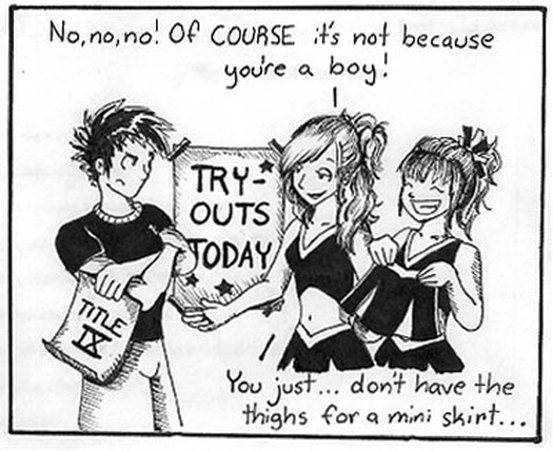People slowly began to realize that the value of athletics for girls' development was an important factor. They found that those women who played sports had overall higher self-esteem, less risk of depression, a lower likelihood of engaging in high-risk behaviors, and better academic performance than girls who did not participate in sporting activities. A few years later, Congress enacted Title IX of the Education Amendments of 1972, which banned sex discrimination in "any education program or activity receiving Federal financial assistance. The Act was modeled after the civil rights legislation of the 1960's. The main objectives of Title IX according to the Supreme Court interpretations were "to avoid use of federal resources to support discriminatory practices and to provide individual citizens effective protection against those practices." All educational programs receiving federal financial assistance were to comply with Title IX's anti-discrimination mandates or risk losing their financial assistance.
To determine whether or not an institution is in compliance with the mandate to "provide equal athletic opportunity for members of both sexes," the following factors are relevant:
(1) Whether the selection of sports and levels of competition effectively
accommodate the interests and abilities of members of both sexes;
(2) The provision of equipment and supplies;
(3) Scheduling of games and practice time;
(4) Travel and per diem allowance;
(5) Opportunity to receive coaching and academic tutoring;
(6) Assignment and compensation of coaches and tutors;
(7) Provision of locker rooms and practice and competitive facilities;
(8) Provision of medical and training facilities and services;
(9) Provision of housing and dining facilities and services;
(10) Publicity
In 1979, HEW (Health, Education and Welfare) issued a Policy Interpretation to clarify the application of Title IX regulations to college athletics to encourage self-policing, and to offer a more detailed measure of equal athletic opportunity. The most important part of the Policy Interpretation was a three-part test for determining compliance:
1. Whether intercollegiate level participation opportunities for male
and female students are provided in numbers substantially
proportionate to their respective enrollments; or
2. Where the members of one sex have been and are underrepresented
among intercollegiate athletes, whether the institution can show a
history and continuing practice of program expansion which is
demonstrably responsive to the developing interests and abilities of
that sex; or
3. Where the members of one sex are underrepresented among
intercollegiate athletes, and the institution cannot show a continuing
practice of program expansion such as that cited above, whether it can
be demonstrated that the interests and abilities of the members of that
sex have been fully and effectively accommodated by the present
program.
The policy required that an institution must meet one of the three anti-discriminatory policies. In 1984, the Supreme Court limited Title IX's scope to the specific school programs receiving federal funds, but three years later the enactment of the Civil Rights Restoration Act of 1987 re-extended Title IX to all programs of an institution receiving federal funds for any program or activity. If an institution did not comply with this mandate, the entire university could risk losing all federal funding. Title IX was remanded once again in 1992 when the Supreme Court established that individuals could sue for money damages for intentional discrimination.
(1) Whether the selection of sports and levels of competition effectively
accommodate the interests and abilities of members of both sexes;
(2) The provision of equipment and supplies;
(3) Scheduling of games and practice time;
(4) Travel and per diem allowance;
(5) Opportunity to receive coaching and academic tutoring;
(6) Assignment and compensation of coaches and tutors;
(7) Provision of locker rooms and practice and competitive facilities;
(8) Provision of medical and training facilities and services;
(9) Provision of housing and dining facilities and services;
(10) Publicity
In 1979, HEW (Health, Education and Welfare) issued a Policy Interpretation to clarify the application of Title IX regulations to college athletics to encourage self-policing, and to offer a more detailed measure of equal athletic opportunity. The most important part of the Policy Interpretation was a three-part test for determining compliance:
1. Whether intercollegiate level participation opportunities for male
and female students are provided in numbers substantially
proportionate to their respective enrollments; or
2. Where the members of one sex have been and are underrepresented
among intercollegiate athletes, whether the institution can show a
history and continuing practice of program expansion which is
demonstrably responsive to the developing interests and abilities of
that sex; or
3. Where the members of one sex are underrepresented among
intercollegiate athletes, and the institution cannot show a continuing
practice of program expansion such as that cited above, whether it can
be demonstrated that the interests and abilities of the members of that
sex have been fully and effectively accommodated by the present
program.
The policy required that an institution must meet one of the three anti-discriminatory policies. In 1984, the Supreme Court limited Title IX's scope to the specific school programs receiving federal funds, but three years later the enactment of the Civil Rights Restoration Act of 1987 re-extended Title IX to all programs of an institution receiving federal funds for any program or activity. If an institution did not comply with this mandate, the entire university could risk losing all federal funding. Title IX was remanded once again in 1992 when the Supreme Court established that individuals could sue for money damages for intentional discrimination.

